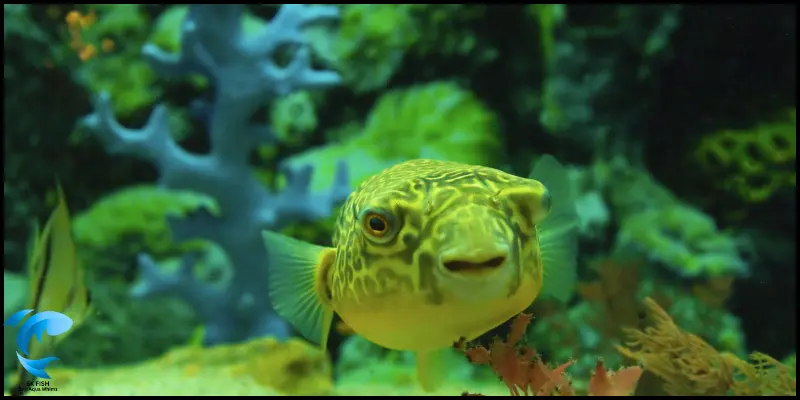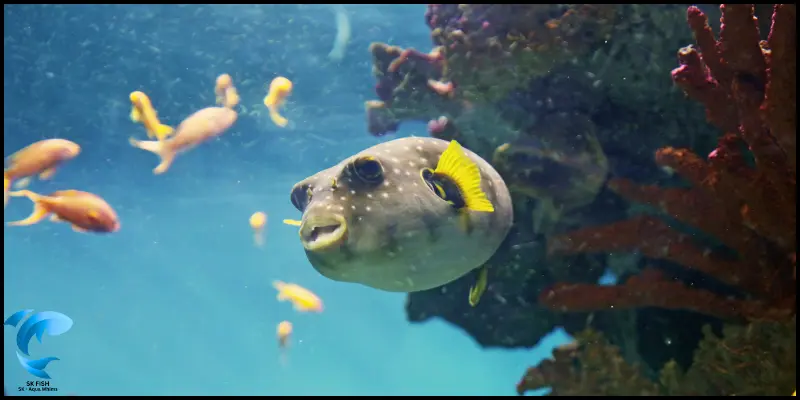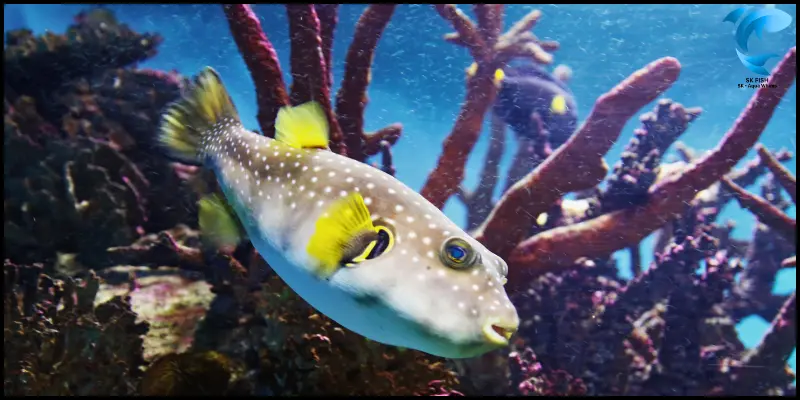Fahaka Puffer Fish Care Sheet | Tips & Tank Setup Guide
Published: 9 Jul 2024
In this article, we will cover everything you need to know about caring for a fahaka puffer fish. This freshwater species is native to South African rivers and lakes. We have put together a comprehensive guide on tank setup, diet, size, growth rate, and overall care for these unique fish.
If you’re looking for a complete fahaka puffer fish care sheet, you’ve come to the right place. Our article contains all the necessary information and tips to help you properly care for your pufferfish in an aquarium setting.
Let’s dive in and learn how to give your fahaka puffer fish the best possible care.
What is the Fahaka Puffer Fish (Tetraodon lineatus)?
The Fahaka Puffer Fish, scientifically known as “Tetraodon Lineatus,” is a popular choice for aquarium enthusiasts due to its adorable appearance. Despite being brilliant creatures, they can be challenging to keep in captivity. However, with proper care and attention, they can thrive.
This comprehensive guide on Fahaka Pufferfish will provide valuable information on how to care for this species. Belonging to the Tetraodontidae family, the Fahaka puffer fish has several names, such as Nile Puffer, Globe Puffer, Amazon Puffer, Band Puffer, and Tetraodon Fahaka. But it is most commonly referred to as the Fahaka puffer.

What is the size of the Fahaka Puffer Fish?
These tropical freshwater fish can grow up to 43 to 45 cm in length, making them one of the largest puffer species and second only to the tetraodon mbu in size.
The growth rate of Fahaka Puffer
In the wild, Fahaka pufferfish experience rapid growth, particularly during the initial stages. Within four weeks, they can grow by 2.5 cm (1 inch) for the first ten months, and even after that, their growth continues for another 12 months. This makes them ideal candidates for being kept in a well-maintained tank.
Fahaka Puffer Fish Tank Setup
Let’s plan out the perfect tank to create a haven for our adorable friend, the Fahaka Puffer.
Fahaka Puffer Tank Size
Fahaka pufferfish are known for their rapid growth and being the largest of all pufferfish species. Due to their size, it is recommended to have a tank size of at least 570 liters (150 US gallons) for them.
Fahaka puffer fish care in water (Water Parameters)
It is important to provide ample space for swimming in their tank, as well as maintaining optimal water conditions. The ideal pH level for fahaka pufferfish is between 6.5 and 8.0, with a water temperature range of 22-26°C (72–80 °F). Ammonia and nitrite levels should always be kept at zero, so it is important to test and monitor these levels regularly. The general hardness (GH) of the water should be between 5-15 dGH.
- pH Level: 6.5 to 8.0
- Water Temperature: 22 – 26°C (72–80 °F)
- Ammonia & Nitrite: NH3 / NO2 = 0 (ammonia and nitrate should always be zero).
- GH: 5-15 dGH
Additionally, decorating the tank in a way that mimics their natural environment is essential for the well-being of fahaka pufferfish. Here is a guide for tank decoration:
Tank Decoration
Decorating the tank is crucial for the well-being of fahaka puffers, as they only thrive in open water areas with hiding places. Feeling exposed can cause them discomfort and stress, so creating a space with plenty of hiding spots is necessary for their safety and comfort.
We carefully arrange the tank, adding a fine substrate layer and strategically placing Anubias, the Amazon frogbit, Limnophila sessiliflora, and caves for hiding spots. However, it’s important to leave enough space in the tank due to the large size of the fahaka fish. It’s also crucial not to overdecorate the tank.

Amazon Puffer Tank Mates
Fahaka pufferfish are known to be extremely hostile towards other fish in the tank. They are also fast-growing and can reach impressive sizes within the Tetraodon genus. It is generally recommended to keep a fahaka puffer alone, but if you must have tankmates, here are some species that may be compatible:
| Tank Mates |
|---|
|
Fahaka Pufferfish Diet
Fahaka pufferfish have a varied diet, they enjoy a diverse menu of crabs, shrimp, and snails. They also snack on worms and other bottom-dwellers. Interestingly, since American crayfish have invaded their habitats, these have become part of the Fahaka’s diet too.
It’s crucial to replicate their natural diet as closely as possible. This means providing a mix of foods that they’d typically find in the wild. Pufferfish enthusiasts around the world strongly recommend this approach to keep these fascinating fish healthy and happy.
Quick Facts: Fahaka Puffer Fish (Tetraodon lineatus) Care Sheet
| Facts About Fahaka Puffer |
|---|
|

Conclusion
Properly caring for a Fahaka pufferfish requires commitment and careful attention to detail. These fish have distinct requirements, such as a specific diet and territorial behaviors, that must be taken into account when preparing their tank and providing food. When given the proper care, they can thrive in captivity and bring delight to any aquarium lover. Understanding and addressing their individual needs should be the top priority for successful care, resulting in a happy and fascinating addition to your underwater community. Share your opinions in the comment section.
FAQs
How do you care for a fahaka puffer fish?
Fahaka puffers need specific living conditions to thrive. A tank with a minimum capacity of 570 liters/150 gallons is necessary, along with ideal water parameters (pH levels between 6.5 and 8.0, a temperature around 22 and 26 °C, and no trace of ammonia or nitrites). It’s also important to have strong filtration in place. Providing a variety of food, such as hard-shelled options, worms, and small fish, will help keep these puffers healthy and happy.
How can you get your pufferfish to inflate?
Pufferfish inflate their stomachs with water as a defense mechanism against predators. However, inducing this behavior in captivity is stressful for them. To prevent inflation, maintain a calm environment, minimize disruptions, and provide suitable tank conditions, the long-spine porcupinefish (Diodon holacanthus) exemplifies this adaptation with its stretchy stomach, which evolved for rapid inflation and defense.
Where do puffer fish live?
Pufferfish inhabit warm waters globally, favoring coastal regions and coral reefs. They thrive in both saltwater and freshwater environments. The Fahaka pufferfish resides in African rivers and lakes, while the long-spine porcupinefish prefers oceanic habitats near reefs and rocky areas for shelter and food.
What is the difference between the fugu and the puffer fish?
The main difference between ‘fugu’ and other pufferfish is their culinary use and geographic origin. ‘Fugu’ refers specifically to toxic species highly prized in Japanese cuisine, requiring careful preparation to remove tetrodotoxin. In contrast, ‘puffer fish’ is a broader term covering over 120 species found globally in marine and freshwater habitats, known for their ability to inflate defensively.

SK Fish is your trusted source for practical fish care tips and delicious seafood recipes. Our team is dedicated to providing reliable, well-researched content for fishing enthusiasts and home cooks alike.

- Be Respectful
- Stay Relevant
- Stay Positive
- True Feedback
- Encourage Discussion
- Avoid Spamming
- No Fake News
- Don't Copy-Paste
- No Personal Attacks



- Be Respectful
- Stay Relevant
- Stay Positive
- True Feedback
- Encourage Discussion
- Avoid Spamming
- No Fake News
- Don't Copy-Paste
- No Personal Attacks





